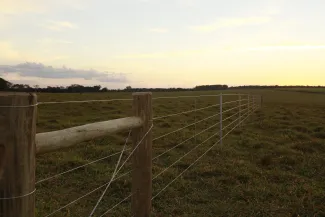
Jeremy Clarkson’s latest TV show, ‘Clarkson’s Farm’, follows his quest to build a sustainable and profitable farm in Oxfordshire, Diddly Squat. He faces multiple challenges including hiring the right team, navigating the complex world of agriculture and overcoming financial hurdles. A key focus of the show is that it draws attention to activities and development on agricultural land which may be classed as “permitted development” and raises questions on what can and cannot be done on land of this nature including existing (and possibly unused) agricultural buildings
Scotland operates under a separate “permitted development” regime to that in England. This regime sets out the uses and building operations which have the benefit of “deemed” planning permission and therefore can be classed as “permitted”. This means that those uses and operations may take place without the need to obtain an express planning permission.
The legislation in Scotland allows some flexibility on developing agricultural land when relying on permitted development rights. An existing agricultural building may be converted into a dwelling or flexible commercial use with a limited amount of building operations in order to implement the conversion. The legislation contains a list of what counts as a flexible commercial use, and includes shops, cafes and restaurants. In addition, the legislation, in some circumstances, grants deemed planning permission for the erection, extension and alteration of an agricultural building but it must be for an agricultural purpose. It may also permit the creation of an access road where the access is required in connection with any of the above activities.
However, the process is not quite as unrestricted as suggested in ‘Clarkson’s Farm’, which includes an attempt by Clarkson to open a restaurant within an existing unused building. As well as a whole host of exclusions and conditions which apply in each circumstance (such as an exclusion on change of use if the building is a listed building or was constructed after 4 November 2019), the developer must apply to the planning authority (the Council) for a determination as to whether “prior approval” by the authority is required. That application must be accompanied by a written statement describing the proposal, its location, its design and even the materials being used. For an application for prior approval in connection with a change to flexible commercial use, this must be accompanied by a series of statements setting out the proposals impact on transport and noise, the risk of contamination and flooding, and the proposed access arrangements. Importantly, the development is not allowed to commence until one of the following has occurred:
- The planning authority has determined that prior approval is not required;
- The prior approval application has been approved; or
- 28 days have passed since the application was submitted to the authority without the authority responding.
Although the permitted development legislation is designed to provide flexibility for agricultural (or related) operations and uses, which can have the benefit of avoiding lengthy planning applications and associated fees, it does contain limitations. It does not allow for agricultural land to become a blank canvas that is permitted to host an abundance of activities, including non-agricultural ones, which may have adverse effects on the land, and which may not meet the conditions and exclusions set out in the legislation. A developer and landowner should always be aware that there may be additional considerations and processes to be followed before any operations or uses can be considered to have the benefit of permitted development rights.
We would always advise that appropriate checks are undertaken to ensure that, where appropriate, permitted development rights can be sought and relied upon. If you have specific queries or issues in respect of permitted development rights, please get in touch with our planning team who would be happy to advise you.